Article and photos by Joe Sapia
Note: The yard references are to my house in the section of Monroe between Helmetta and Jamesburg in South Middlesex County. My yard is in a Pine Barrens outlier on the Inner Coastal Plain, the soil is loamy, and my neighborhood is on the boundary of Gardening Zones 6b (cooler) and 7a (warmer). Notes and photographs are by the author and for the period covered, unless otherwise noted.
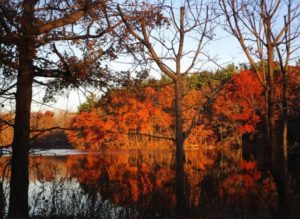 The foliage change of colors may be past its peak, but the colors continue to dazzle. Here, morning sunlight shines on a cove in a section of Farrington Lake on the East Brunswick-North Brunswick boundary in Middlesex County.
The foliage change of colors may be past its peak, but the colors continue to dazzle. Here, morning sunlight shines on a cove in a section of Farrington Lake on the East Brunswick-North Brunswick boundary in Middlesex County.
VOICES FROM AFIELD, DIANE LARSON, EAGLES: Diane Larson, who lives along Beaver Dam Creek in Brick, Ocean County, checked in: “Just wanted to share what happened (Sunday, November 26) morning. We noticed the seagulls abruptly flying, like they were spooked, then saw these two guys flying right above our house, and landed on the house across the lagoon from us!” Bald eagles, “Haliaeetus leucocephalus.” In New Jersey, the species is “endangered” as a breeder, or in immediate peril, and “threatened” otherwise, meaning if conditions continue, it could become “endangered.” “They flew in the area all morning, it was awesome to watch,” Diane said.
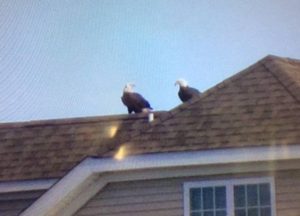
Two bald eagles in the Beaver Dam Creek area of Brick, Ocean County. (Photograph copyright 2017 by Diane Larson)
MORE EAGLES: Michael Franken has been reporting bald eagles from the boundary of Cranbury and Plainsboro in Middlesex County.
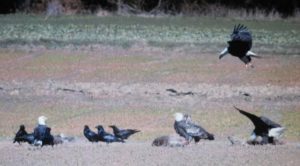
Bald eagles on a deer carcass along the Cranbury-Plainsboro boundary in Middlesex County. (Photo copyright 2017 by Michael Franken Photography)
VOICES FROM AFIELD, DIANE LARSON, NO. 2, JUNCOS: Diane Larson, who is the home horticulturist for the Monmouth County office of the Rutgers University Cooperative Extension, said, “I just went out to the back to check on the gardens behind our office. I heard unfamiliar bird sounds and followed them to see dozens of juncos (“Junco hyemalis,” or snowbird) on a tree back there. I then saw why they were there. They were all around the sweetgum tree (“Liquidambar styraciflua”) eating the seeds from the sweetgum balls.”
SNOWY OWLS: Reports are coming in of snowy owls, “Bubo scandiacus,” down from the Arctic. In recent years, I have heard two theories on the uptick of snowy owls in our area, both related to their food of choice, lemmings, “Dicrostonyx torquatus.” One is that there could be a shortage of lemmings, so the owls migrate farther than normal to find food. The other theory is there was an abundance of lemmings and because of this, owls prospered, having more offspring. A snowy owl story from nj.com: http://www.nj.com/ocean/index.ssf/2017/11/snowy_owl_explosion_expected_in_new_jersey_this_ye.html.
DRIVE-BY NATURALIST, STARLINGS: As I was walking through the Rutgers University campus in downtown New Brunswick, Middlesex County, I encountered a flock of starlings, flying and perching in trees. “For much of the year, they wheel through the sky and mob lawns in big, noisy flocks,” according to Cornell University’s All About Birds website. Starlings, “Sturnus vulgaris,” are non-native. “First brought to North America by (playwright William) Shakespeare enthusiasts in the 19th Century, European Starlings are now among the continent’s most numerous songbirds,” according to All About Birds.
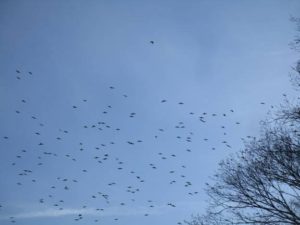
A flock of starlings at Rutgers University in New Brunswick, Middlesex County.
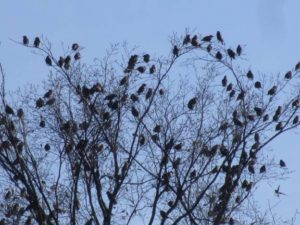
Perched starlings at Rutgers University in New Brunswick, Middlesex County.
DRIVE-BY NATURALIST, SUNSET: As I was headed to the Rocky Hill area of Somerset County, I came across a beautiful sunset on the Monroe-South Brunswick boundary in Middlesex County. It was a wonderful orange sky, with the farmland I was photographing across providing “big sky” views.

Sunset on the boundary of Monroe and South Brunswick, Middlesex County.
EARTHQUAKE: On Thursday, November 30, the rumble you may have felt was a 4.1 earthquake centered near Dover, Delaware. The Did-You-Feel-It response to the United States Geological Survey, https://earthquake.usgs.gov/earthquakes/eventpage/us1000bjkn#dyfi.
HURRICANE SEASON: The Atlantic Ocean hurricane season ended Thursday, November 30. During the season, which began June 1, there were 17 named storms of which 6 were major hurricanes, according to Channel 6 television in Philadelphia. “Three Category 4 hurricanes” – those with winds of 130 to 156 miles per hour — “made US landfall,” according to Channel 6. A primer on hurricanes from the National Hurricane Center, http://www.nhc.noaa.gov/aboutsshws.php.
‘LIVING SHORELINES’ PROPOSAL: Congressman Frank Pallone, who lives in Long Branch, is to introduce legislation creating the Living Shorelines Act, which would provide federal grant money for building up shorelines with plants and other natural materials. The idea is to prevent flooding and erosion, along with providing habitat, in a natural way. See Pallone’s op-ed in the Wednesday, November 29, Asbury Park Press, http://www.app.com/story/opinion/columnists/2017/11/29/living-shorelines-act-frank-pallone/108143866/.
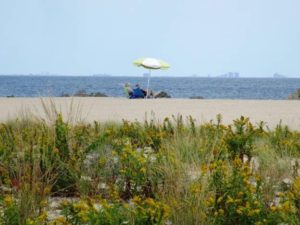
In this 2016 photograph, an Atlantic Ocean natural beach at Sandy Hook, Monmouth County, with the New York City area in the background.
CHRISTMAS TREES, SLIM PICKINGS AND HIGHER PRICES: We were just talking about how fewer trees were planted because of the Great Recession about 10 years ago. And, 10 years later, those trees are ready – in smaller numbers and, in turn, higher prices. Here is a New York Times story on the matter, https://www.nytimes.com/2017/11/30/business/christmas-tree-shortage-recession.html.
DEER RUT: A 63-year-old Franklin, Somerset County, died from injuries suffered in a motor-vehicle accident in his hometown that happened during the ongoing mating season, or rut, of deer, “Odocoileus virginianus.” Be careful while driving, especially during the rut, which will likely extend into about mid-December.
FULL MOON: The upcoming full moon — the Full Long Night Moon on the December 3-4, Sunday-Monday overnight — will be 2017’s only full “super moon,” that is, when the full moon comes close to the Earth, or 222,443 miles away. The closest will be at 4 a.m. Monday, December 4, when the moon will appear “about 7 percent larger and 16 percent brighter than usual,” according to the National Geographic.

The near-full moon around 4 a.m. from my backyard in Monroe, Middlesex County.
OCEAN TEMPERATURE: The Atlantic Ocean temperature at Sandy Hook was about 48 degrees over the Dec. 2-3 weekend.
SUNRISE/SUNSET: For Sunday, December 3, to Saturday, December 9, the sun will rise about 7:05 to 7:10 a.m. and set about 4:30 p.m. For Sunday, December 10, to Saturday, December 16, the sun will rise about 7:10 to 7:15 a.m. and set about 4:30 to 4:35 p.m.
WEATHER: The National Weather Service forecasting station for the area is at http://www.weather.gov/phi/.
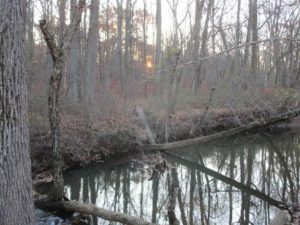
Sunrise at Manalapan Brook in Monroe, Middlesex County.
Joe Sapia, 61, is a lifelong resident of Monroe — in South Middlesex County, where his maternal family settled more than 100 years ago. He is a Pine Barrens naturalist and a gardener of organic vegetables and fruit, along with zinnias and roses. He draws inspiration on the Pine Barrens around Helmetta from his mother, Sophie Onda Sapia, who lived her whole life in these Pines, and his Polish-immigrant grandmother, Annie Poznanski Onda. He gardens the same backyard plot as did his Grandma Annie and Italian-American father, Joe Sr. Both are inspirations for his food gardening. Ma inspires his rose gardening. Joe is a semi-retired print journalist of almost 40 years. His work also is at @JosephSapia on Twitter.com, along with Facebook.com on the Jersey Midlands page.
Copyright 2017 by Joseph Sapia
Article and photos by Joe Mish
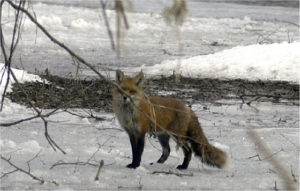
Portrait of a sycamore branch with a fox in the background. Female fox was so intent on her early morning hunt, I was able to get within 30 paces before she noticed me.
Snow follows December like a lazy white shadow that lingers in the bright light of day. A shadow of some substance that accumulates to measurable depth, can be blown about by the wind and reveal hidden secrets of elusive wildlife.
The stillness of a cold overcast day can foretell the coming of December’s white shadow, soon to arrive. The first flakes drift slowly to earth as the shadow begins to appear. A single snow flake landed intact on my wool mitten, suspended on an errant fiber. The intricate artistry nature expressed in this one crystal represented the beauty of uncountable trillions more. The hidden beauty, however, is often lost as the shadow deepens.
Falling snow covered me and my canoe as I sought safe harbor in a narrow slush filled stream bordered by high banks. The canoe was stabilized in the slush and I felt comfortable adjusting my gear to warm my hands. As I sat hunched over the snow began to build, essentially hiding me within its shadow. Suddenly a large male mink came loping through the deep snow, intent on crossing the small stream. My snow-covered boat must have been a welcome bridge to avoid the icy water. Just as the mink, now four feet away, was about to jump into my boat, he suddenly caught my scent and retreated into a nearby groundhog den. This was a unique situation, where I saw what happened and then in hindsight, was able to read the story the tracks left in the snow. It was like being at the scene of an unfolding drama and later watching it in a news report.
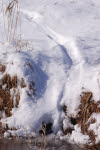
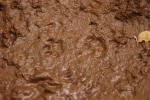
Mink trail in the snow and tracks in the mud.
I followed fresh fox tracks one morning not realizing how fresh they were. With the wind in my favor and dressed in white coveralls, I walked along observing where the fox stopped to sit, waiting for sound or scent to betray the location of a mouse under the snow. Apparently, nothing materialized, as the fox continued on its original straight-line path, stopping again to listen for a scurrying mouse hiding deep within in December’s white shadow. Here at last were telltale signs the fox made an attempt to catch the elusive rodent.
From a sitting position, it shuffled its hind feet and leaped several feet ahead, going air born before landing and stomping around and stabbing its face into the deep snow. The absence of blood or fur suggested the effort was futile as the fox continued on, heading toward a large pile of tree branches deposited along the riverbank by a previous flood. I looked up from the tracks in the snow to see the fox a moment before it saw me. I had only a split second to react and get the camera focused. We were only thirty steps apart as I digitized the suspicious fox staring back at me. Neither of us moved for a long moment until the fox slowly turned, began to walk away and then stopped to pee. Perhaps she was expressing her displeasure at having her hunt disturbed and left her scent to reaffirm ownership of her home territory.
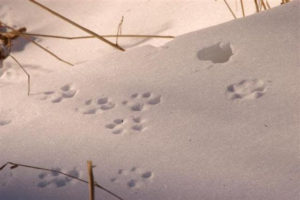
Fox tracks in the new snow with strands of straw colored grass bathed in the contrast of subtle light changes would make a fine Christmas card from the fox. The tracks convey a signed message that translates even to those who aren’t conversant in the language of ‘fox’.
December’s telltale shadow is an open book even the wind uses as a message board. Capable of producing destructive storms of biblical proportion, the wind shows its gentler side, using a single blade of grass to whimsically etch it thoughts in the snow.
December owns the darkest days of the year and when the moment of darkness is greatest, at the instant of the winter solstice, it gives birth to light as day length begins to increase. Light or dark, December’s shadow is not far behind, casting a trace of white.
Author Joe Mish has been running wild in New Jersey since childhood when he found ways to escape his mother’s watchful eyes. He continues to trek the swamps, rivers and thickets seeking to share, with the residents and visitors, all of the state’s natural beauty hidden within full view. To read more of his writing and view more of his gorgeous photographs visit Winter Bear Rising, his wordpress blog. Joe’s series “Nature on the Raritan, Hidden in Plain View” runs monthly as part of the LRWP “Voices of the Watershed” series. Writing and photos used with permission from the author.
Article and photos by Joe Sapia
Note: The yard references are to my house in the section of Monroe between Helmetta and Jamesburg in South Middlesex County. My yard is in a Pine Barrens outlier on the Inner Coastal Plain, the soil is loamy, and my neighborhood is on the boundary of Gardening Zones 6b (cooler) and 7a (warmer). Notes and photographs are for the period covered, unless otherwise noted.
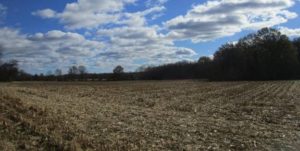
Farmers are harvesting field corn as fall turns into winter. Here, a cut-down cornfield in Monroe, Middlesex County. We have seen a wide fluctuation of temperatures this fall, from summer-like to winter-like, but look out for long days of cold, perhaps accompanied by snow.
FARMING: Look for the traditional farming season to wrap up. Farmers are continuing to harvest field corn, for example. Meanwhile, we are transitioning into the winter holidays season at Christmas tree farms.
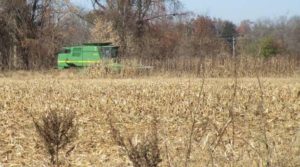
A farmer works a corn field outside Neshanic Station, Somerset County.
CHRISTMAS TREE FARMS: For those seeking trees from local farms, whether recent cuts or cut-your-own, here is the New Jersey Christmas Tree Growers Association website’s farm locater, https://njchristmastrees.net/find-a-farm/. Keep in mind, all Christmas tree farms may not be listed. (I heard an interesting radio news report regarding Christmas trees in America. The report said we are facing the effects of the recession 10 years ago – that is, with the recession, farmers planted less trees and with those trees now reaching cutting time, there are less trees. In turn, higher prices. The report said this will go on for years.)
DEER RUT: While I have not noticed any bucks roaming lately — because, I suspect, the mating season, or rut, of deer, “Odocoileus virginianus,” is peaking and bucks and receptive does are holed up in the seclusion of woods — I did come across a dead buck on farmland in Monroe, Middlesex County. It was a fresh kill and near a busy road, so he probably was a victim of a motor vehicle accident. Additionally, he was probably sex-crazed and less wary, crossed the road, and got hit. I noticed the dead buck because nature was taking its course and vultures were feasting upon him. Definitely turkey vulture, “Cathartes aura”; Maybe black vulture, “Coragyps atratus,” too.
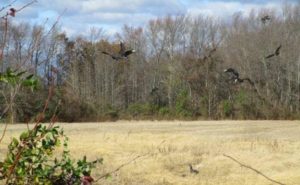
I spooked these vultures when I stopped to photograph them on a deer carcass in Monroe, Middlesex County. Notice the dead buck on the middle-to-right bottom of the photograph.
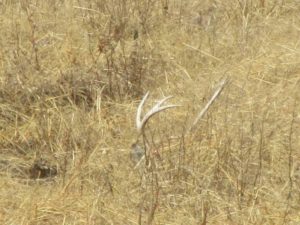
The dead buck appeared to be a pretty good size.
DEER HUNTING: Various deer-hunting seasons have been underway and will continue into 2018, with “Deer Week,” or the Six-Day Shotgun Season, being Monday, December 4, to Saturday, December 9. (If you are traveling through the Pine Barrens, take note of those primitive buildings that are quiet for 51 weeks of the year. During Deer Week, they will be hopping.) Anyway, be careful if heading into the woods during deer seasons. One, it might be advisable to stay out of the woods. Two, if you are in the woods, at least wear blaze orange. Three, during Deer Week, just stay out of the woods unless you are hunting. A year or so ago, I walked underneath a bowhunter in a deer-stand, never seeing him until he spoke to me from above. Fortunately, I wore blaze orange and was obvious to him. This rattled me into thinking I am not as aware of my woods surroundings as I should be.
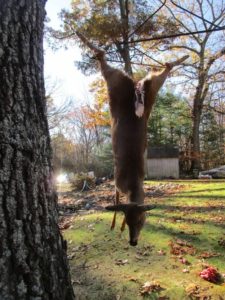
This doe was killed in the Route 33 area of Manalapan, Monmouth County.
FALL FOLIAGE: The Jersey Midlands are past the peak of the changing colors of fall, but there were some beautiful brown/Earth-tone views.

Fall foliage and a cloudy sky at Westminster Cemetery in Cranbury, Middlesex County.

A sunny day upon the fall foliage along Manalapan Brook in Monroe, Middlesex County.
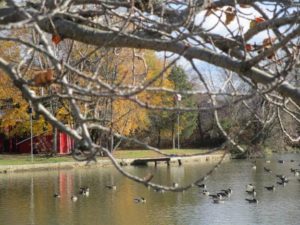
“Englishtown Lake” (properly Lake Weamaconk) in Monmouth County. The lake is formed by the damming of Weamaconk Creek, part of the Raritan River-Bay watershed.
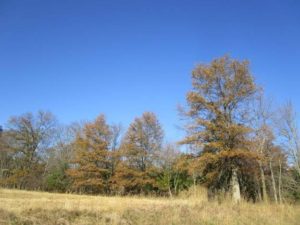
Farmland below Sourland Mountain in Montgomery, Somerset County.
SOURLAND MOUNTAIN: This week, I had to go to Hillsborough, Somerset County, to attend a funeral service. Because I was nearby, I took a ride to Sourland Mountain on the boundary of Somerset, Hunterdon, and Mercer counties. Sourland Mountain, also known as Neshanic Mountain and Zion Mountain, sits on the Piedmont geological area. It runs about 10.5 miles by 4.5 miles and rises about 570 feet above sea level, with its surrounding lowlands as low as about 90 feet above sea level.
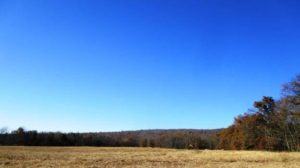
Looking across farmland at Sourland Mountain at Montgomery, Somerset County.
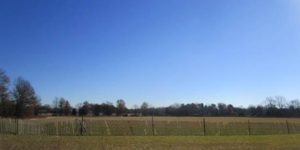
Fencing to hold back snow drifting on roads at Montgomery, Somerset County.
RARITAN RIVER SOUTH BRANCH: The South Branch of the Raritan River is 51 miles long, draining 276 square miles in Somerset, Hunterdon, and Morris counties. It meets the North Branch north of Neshanic Station, forming the main stem of the Raritan River.
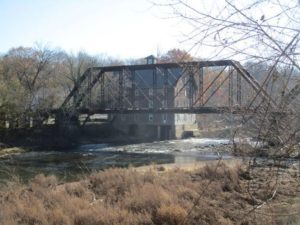
An old railroad bridge and mill on the South Branch of the Raritan River at Neshanic Station.
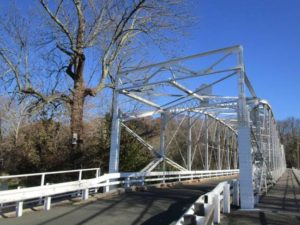
The one-lane, 1896 iron bridge over the South Branch of the Raritan River, connecting Branchburg and Hillsborough at Neshanic Station, Somerset County.
VOICES FROM AFIELD, EAGLES: Michael Franken checked in regarding bald eagles, “Haliaeetus leucocephalus.” He reported seeing them on the boundary of Cranbury and Plainsboro, Middlesex County, Thanksgiving Day and Black Friday. In New Jersey, the bald eagle is “endangered,” or in immediate peril, as a breeder and “threatened,” or if conditions continue or begin to deteriorate, they will advance to endangered, in general. The state Division of Fish and Wildlife bald eagle page is http://www.state.nj.us/dep/fgw/ensp/pdf/end-thrtened/baldeagle.pdf.
DRIVE-BY NATURALIST, BIRD OF PREY: I was driving through a farming area of South Brunswick, Middlesex County, and came across a bird of prey perched in a tree. I could not get a good look or a good photograph of the bird. Later, in looking at the photo on my computer, the bird’s head appeared to be somewhat, perhaps not that blatantly, lighter than the body. A bald eagle, “Haliaeetus leucocephalus,” transitioning from juvenile to adult?
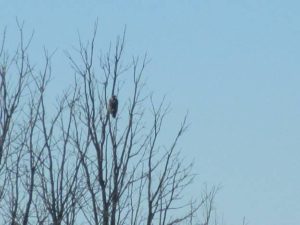
A bald eagle, “Haliaeetus leucocephalus,” transitioning from juvenile to adult?
FULL MOON: The upcoming full moon — the Full Long Night Moon on the December 3-4, Sunday-Monday overnight — will be 2017’s only full “super moon,” that is, when the full moon comes close to the Earth, or 222,443 miles away. The closest will be at 4 a.m. Monday, December 4, when the moon will appear “about 7 percent larger and 16 percent brighter than usual,” according to the National Geographic.

Around 5 p.m. November 20, Monday, or a short time after sunset, there was a beautiful rainbow-shaped and -colored cloud in the western sky. The color was caused by the reddish sunlight from under the horizon hitting the cloud. And more toward the southwest was the crescent moon. What a view! (The photos, all shot from my yard, from where I have watched the night sky since the American-Soviet “Space Race”: the moon, stars, planets, meteorites, and the International Space Station.)
DARK SKIES: As you probably can tell, I am a big fan of a dark sky, to be able to see the stars, planets, satellites clearly. When I remodeled my house over the summer, I insisted on shielded outside lighting, which directs my three outside lights downward, not horizontally or upward. (At night, a shielded light will emit a cone of light, while an unshielded light emits a blinding burst of light. Also, red and green lights protect night vision.) On Saturday, November 25, I heard this story on NPR, about a proposal for part of Idaho to get recognized by the International Dark-Sky Association as a “dark sky reserve,” https://www.npr.org/2017/11/25/566074921/idaho-dims-the-lights-for-one-of-the-best-night-skies-anywhere. Go, Idaho! (I plan to be in Idaho for a wedding in August and hope to see that Idaho dark sky. Give people a wonderful view – turn off lights that project into the sky!)
AROUND PEDDIE LAKE: There were some nice views at Peddie Lake at Hightstown, Mercer County. The lake is about 15 acres, created by the damming of Rocky Brook, part of the Raritan River-Bay watershed. The Peddie School, a preparatory school, sits along the lake.
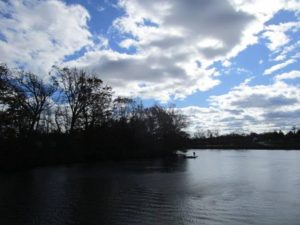
A fisherman on Peddie Lake under a partly cloudy sky.
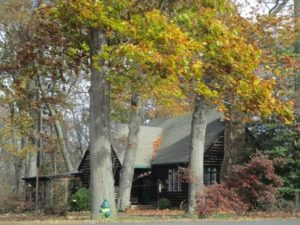
The Peddie Lake cabin.
PROTECTING THE JERSEY MIDLANDS: The Jersey Midlands are an incredible environmental resource: the Atlantic Ocean and other coastal waters, the Outer and Inner Coastal Plains, the Piedmont, the Pine Barrens, the Delaware River, valuable farmland. This alone is evidence of why we should protect the Midlands environment. But, more so, the area is under intense development pressure and stress because of its location at the New York City and Philadelphia metropolitan areas.
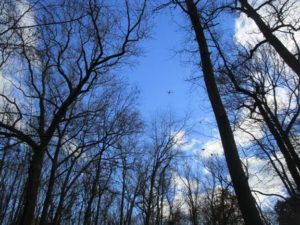
Despite the beauty here of the blue sky above the Manalapan Brook floodplain in Monroe, Middlesex County, notice the commercial jet in the sky, probably headed for Newark Airport. The Midlands are under intense stress because of they are part of both the New York City and Philadelphia metropolitan areas.
OCEAN TEMPERATURE: The Atlantic Ocean temperature at Sandy Hook was about 47 degrees over the November 25-26, Saturday-Sunday, weekend.
SUNRISE/SUNSET: For November 26, Sunday, to December 2, Saturday, the sun will rise about 6:55 to 7:05 a.m. and set about 4:30 to 4:35 p.m. For Sunday, December 3, to Saturday, December 9, the sun will rise about 7:05 to 7:10 a.m. and set about 4:30 p.m.WEATHER: The National Weather Service forecasting station for the area is at http://www.weather.gov/phi/.
CLOUDS: This week’s cloud photographs were captured at Monroe and Jamesburg, Middlesex County.

“Jamesburg Lake” (properly Lake Manalapan), looking from Monroe toward Jamesburg, Middlesex County.
IN THE GARDEN AND YARD: I try to get the yardwork done by Thanksgiving weekend. So far, the lawn has been cut for the last time, shrubs have been spruced up in the front yard, the gutters and drainpipes have been cleaned in the front of the house, the crawlspace where a two-room addition was put on the house circa 1967 has been secured, and the garage door and front cellar window well has been cleaned. Still to go, sprucing the backyard shrubs, cleaning the rear gutters and drainpipes, raking leaves into the garden, and, perhaps, roto-tilling the garden. I will not get the outside painting I had planned done. As the outside work ends, I have a ton of stuff to do inside over the winter.

The garden in my backyard in August.
 This week in the garden.
This week in the garden.
UNEXPECTED WILDLIFE REFUGE: A little south of the Jersey Midlands, in Atlantic County, are our friends at the Unexpected Wildlife Refuge. Veronica Van Hof, the director, is seeking help in meeting a challenge. “As another way of supporting the Refuge, we have been accepted to be part of the Newman’s Own Foundation $500,000 Holiday Challenge, administered through CrowdRise,” Veronica said. “Every donation (‘voting’) through our page at CrowdRise increases the chance of our receiving additional funding through one of the Challenge prizes which range from $2,500 for 10th place up to $150,000 for first place.” The challenge runs to January 3. The challenge is at https://www.crowdrise.com/o/en/campaign/unexpected-wildlife-refuge-inc/unexpected-wildlife-refuge. More about Unexpected is at http://www.unexpectedwildliferefuge.org.
UPCOMING:
December 3, Sunday, 10 a.m. to 1 p.m. – Green Brook Cleanup at the Green Brook Regional Center, 275 Greenbrook Road, Green Brook, Somerset County, with the Lower Raritan Watershed Partnership and the Central Jersey Stream Team. More information at hfenyk@lowerraritanwatershed.org.
December 8, Friday, 2 p.m. to 3:30 p.m., Middletown, Monmouth County – “Forest Therapy” Walk, hosted by the Monmouth Conservation Foundation. “It is not intended to be a strenuous hike, but a time for mindful awareness in nature,” according to the foundation. More information, abrockwell@monmouthconservation.org.
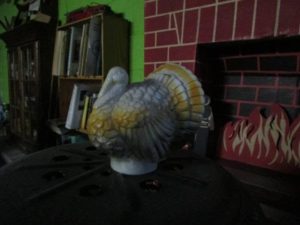
This turkey survived Thanksgiving. (Compliments of the eclectic Joey Archives: A plastic turkey from my 1960s youth, pictured in the faux cabin section of my basement.)
Joe Sapia, 60, is a lifelong resident of Monroe — in South Middlesex County, where his maternal family settled more than 100 years ago. He is a Pine Barrens naturalist and a gardener of organic vegetables and fruit, along with zinnias and roses. He draws inspiration on the Pine Barrens around Helmetta from his mother, Sophie Onda Sapia, who lived her whole life in these Pines, and his Polish-immigrant grandmother, Annie Poznanski Onda. He gardens the same backyard plot as did his Grandma Annie and Italian-American father, Joe Sr. Both are inspirations for his food gardening. Ma inspires his rose gardening. Joe is a semi-retired print journalist of almost 40 years. His work also is at @JosephSapia on Twitter.com, along with Facebook.com on the Jersey Midlands page.
Article and photos by Joe Sapia
Note: The yard references are to my house in the section of Monroe between Helmetta and Jamesburg in South Middlesex County. My yard is in a Pine Barrens outlier on the Inner Coastal Plain, the soil is loamy, and my neighborhood is on the boundary of Gardening Zones 6b (cooler) and 7a (warmer). Notes and photographs are for the period covered, unless otherwise noted.
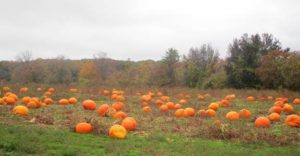
Pumpkins and fall foliage, both taking a last stand for the season, at the Red Wagon Farm Market on Route 33 and Smithburg Road/Route 527-A in Manalapan, Monmouth County.
SNOWBIRDS: I saw the first “snowbirds,” or dark-eyed juncos, “Junco hyemalis,” of the season on Tuesday, November 7, Election Day, around sunrise at St. James Cemetery in Monroe, Middlesex County. The birds are easy to identify by their gray tops and white undersides – “gray skies above, snow below” – and the white edges of their splayed tails as they take off. My rule of thumb is to look for these birds around Halloween, October 31, arriving for the cold weather from as close as the high ground of North Jersey or Pennsylvania and as far away as Canada. Around my yard, I look for these small birds on the ground under the bird-feeder or in bushes. I will see them around my yard to about mid- to late April.
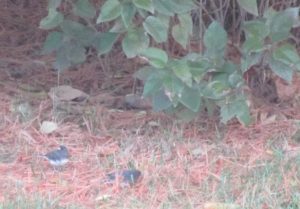
I saw the first “snowbirds,” or dark-eyed juncos, of the season Tuesday, November 7, Election Day, at St. James Cemetery in Monroe, Middlesex County. These birds arrive from the north for the cold-weather season.
VOICES FROM AFIELD, MORE WINTER BIRDS: Diane Larson, a long-time gardening mentor, checked in on the afield side, regarding Beaver Dam Creek in Brick, Ocean County. “Another bird sign of winter – the buffleheads (“Bucephala albeola’’) and mergansers (genus “Mergus”) arrived in Beaver Dam Creek right on schedule – saw them Saturday (November 4) for the first time. We also have otters (“Lutra Canadensis”). They are very elusive, but we’ve seen them and heard them splashing in the water around 8:00 p.m. one night (during) the last week of October. We went outside and tried to see them, but they swam away. All we saw was their wake and heard their grunts.”
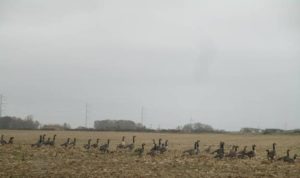
Canada geese, “Branta canadensis,” on the Skeba Farm in the Applegarth section of Monroe, Middlesex County.
BIRDS IN MY YARD: As I was doing yardwork, birds were feasting on corn hearts at my backyard bird-feeder: dark-eyed junco, “Junco hyemalis”; mourning dove, “Zenaida macroura”; tufted titmouse, “Baeolophus bicolor”; and Carolina chickadee, “Poecile carolinensis.”
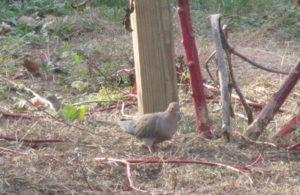
A Mourning Dove at my Backyard Bird-feeder

A Tufted Titmouse at my Backyard Bird-Feeder
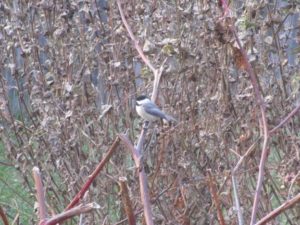
A Chickadee at my Backyard Feeder
GARDEN AND YARD: As I cut the lawn, hopefully for the last time of the year, I smelled wild onions I had mowed down. A bittersweet scent – one pointing back at the year’s peak of vegetable growing, one pointing to a gardening season that lingers. The Jamesburg-to-New Brunswick area of Middlesex County got down to about 20 degrees on the Friday-Saturday, November 10-11, overnight, pretty much bringing an end to the warm weather gardening season. However, I did find a few cherry tomatoes in my garden. (I have a cool weather crop of carrots planted. So, I am hoping for some kind of harvest.) So, this week, I cut the lawn, dumped my last barrel of gardening water, and mowed down the garden, except for the carrots. As for the yard work, I try to get that all done by Thanksgiving.
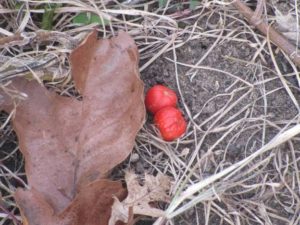
I found these cherry tomatoes in my garden. The top one was in good condition and I popped it into my mouth right in the yard and ate it.
VOICES FROM AFIELD, NO. 2, LINGERING SPRING: Last week, I mentioned I thought I heard the call of a spring peeper treefrog, “Pseudacris crucifer,” at Farrington Lake on the boundary of South Brunswick, East Brunswick, and North Brunswick in Middlesex County. They are normally early spring callers. Jean Montgomerie, an environmental scientist who lives in Freehold and works in the Pine Barrens, said, “Those were spring peepers; I heard them last week too.” Spring, in the form of fall, is playing itself out again, this year.
NIGHT SKY: With the cold spell at the end of the week, I stood in my yard between about 10:30 p.m. and 11:30 p.m. and looked at the night sky. With the temperature at about 23 degrees and very little moisture in the air (with a dewpoint of about 8 degrees), it was one of the clearest night skies I recall, with great views of Auriga (overhead/east); Pleiades, or Seven Sisters (overhead); Orion (southeast); the Great Square of Pegasus (southwest); Cassiopeia (northwest); and the North Star. Take advantage of cold, dry fall and winter overnights. Get a revolving star chart, turn off the outside lights, go outside and acclimate your eyesight to the darkness, and look into the night sky.
THE MOON: The moon is waning from the Full Frost Moon of the November 3-4 overnight. The next full moon is the Long Night Moon on the December 2-3 overnight.

The morning moon, with the changing colors of the fall foliage underneath, at St. James Cemetery in Monroe, Middlesex County. The moon is waning from the Full Frost Moon of the November 3-4 overnight. The next full moon is the Long Night Moon on the December 2-3 overnight.
FALL FOLIAGE: The changing colors of fall foliage are all over the place – some past full color, some peaking, some yet to come. I take the colors as they come, rather than concentrating on a peak.
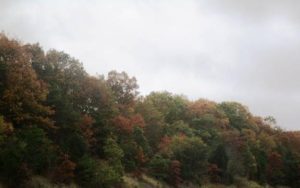
The changing colors of the fall foliage along Interstate 195 in Jackson, Ocean County.
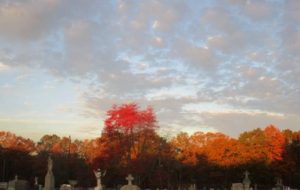
The rising sun’s light hits the top of the trees, lighting up the fall colors, at St. James Cemetery in Monroe, Middlesex County.
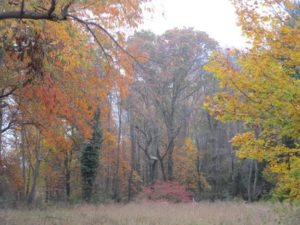
The changing colors between Davidson Mill Park and Pigeon Swamp in South Brunswick, Middlesex County.
DRIVE-BY NATURALIST, RED-TAILED HAWK: As I was returning home from my normal Sunday routine of lunch at the Hightstown Diner in Mercer County, I crossed the Millstone River on the boundary of Cranbury, Middlesex County, and East Windsor, Mercer County. On the Cranbury side, a large bird flew out of the trees, then low along the roadway – a red-tailed hawk, “Buteo jamaicensis.” I cranked off a shot on my camera. Not a good shot, but that is photojournalism – you take what you get, because the news does not necessarily stop for the journalist. The photo, at least, puts in perspective how low the bird was.
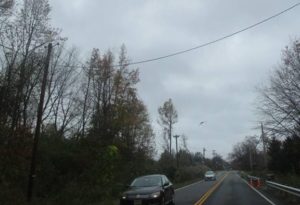
A red-tailed hawk flies low along a roadway on the boundary of Cranbury, Middlesex County, and East Windsor, Mercer County.
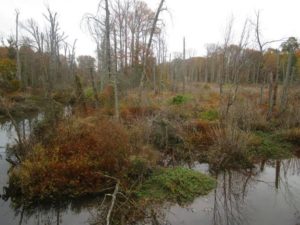
The Millstone River on the boundary of Cranbury, Middlesex County, and East Windsor, Mercer County.
VOICES FROM AFIELD, NO. 3, DEER RUT: I continue seeing normally hidden male deer, “Odocoileus virginianus,” because it is the mating season, or rut. This week, I saw one in southern Monroe, Middlesex County, at night. Then, as I was driving to work one morning in daylight, a deer bolted across a paved road in the Jamesburg Park Conservation Area in the Pine Barrens around Helmetta, Middlesex County. I did not get a good look at the deer, but, based on the way it bolted across the street and because I saw no others, my guess is it was a buck. Paul Migut checked in from South River, Middlesex County: “Spotted buck behind my firehouse. He’s been chasing two does around here.” Again, be careful driving during the rut, which should last until about mid-December.
CLOUDS: This week’s cloud shots are from St. James Cemetery in Monroe, Middlesex County. My family has had a plot there for more than 100 years, since my maternal grandfather, Michael Onda, died in 1917, October.

Clouds over St. James Cemetery in Monroe, Middlesex County.

More clouds from St. James Cemetery in Monroe, Middlesex County.

And more clouds from St. James Cemetery in Monroe, Middlesex County.
VOICES FROM AFIELD, N0. 4, SWIMMING RIVER: Rik van Hemmen, sailor and advocate for the Navesink River watershed, Monmouth County, checked in: “Two weeks ago, just before I hauled my Sea Bright skiff for the winter, we had a perfect tide going up the Swimming River with friends who had never done it before. As is common, it blew their minds to see all this natural beauty.”

Fall on the Swimming River in Monmouth County. (Photograph copyright 2017 by Rik van Hemmen.)
OCEAN TEMPERATURES: Atlantic Ocean temperatures on the New Jersey coast were about 50 degrees to 53 degrees over the November 11-12 weekend.
SUNRISE/SUNSET: For November 12, Sunday, to November 18, Saturday, the sun will rise about 6:40 to 6:45 a.m. and set about 4:35 to 4:40 p.m. For November 19, Sunday, to November 25, Saturday, the sun will rise about 6:50 to 6:55 a.m. and set about 4:35 p.m.
WEATHER: The National Weather Service forecasting station for the area is at http://www.weather.gov/phi/.
IN THE BACKYARD: As I was wrapping up this week’s “Notes from Garden and Afield,” I took a soda break. While in the kitchen, I grabbed four gourds I had on display on the table, opened the back door, stood on the back porch, and threw the gourds across the lawn into the garden. I threw one into a pitch pine, “Pinus rigida,” bordering lawn and garden. A bird must have been in the tree, because a large bird flew out and past me eye-high. Wow! On that note….
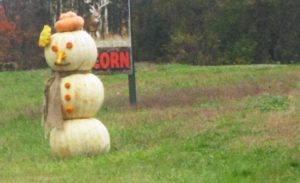
Say, good night, Pumpkin Person. (A pumpkin person at the Red Wagon Farm Market on Route 33, Manalapan, Monmouth County.)
Joe Sapia, 60, is a lifelong resident of Monroe — in South Middlesex County, where his maternal family settled more than 100 years ago. He is a Pine Barrens naturalist and a gardener of organic vegetables and fruit, along with zinnias and roses. He draws inspiration on the Pine Barrens around Helmetta from his mother, Sophie Onda Sapia, who lived her whole life in these Pines, and his Polish-immigrant grandmother, Annie Poznanski Onda. He gardens the same backyard plot as did his Grandma Annie and Italian-American father, Joe Sr. Both are inspirations for his food gardening. Ma inspires his rose gardening. Joe is a semi-retired print journalist of almost 40 years. His work also is at @JosephSapia on Twitter.com, along with Facebook.com on the Jersey Midlands page.
New Jersey’s Gubernatorial Elections are just a week away! Here are a few things to think about as you prepare to go to the polls.
I. New Jersey Ballot Question #2
In addition to voting for our next Governor, New Jersey voters will be asked to vote on Public Question #2, the “Revenue from Environmental Damage Lawsuits Dedicated to Environmental Projects Amendment” question.
The LRWP encourages New Jersey voters to vote YES on this important ballot question. A YES vote would require that Natural Resource Damages funds be used ONLY for their intended purpose of restoration and environmental cleanup. In years prior, more than 80% of supposedly dedicated environmental clean-up funds were instead appropriated for the state’s general operating budget.
According to the ballot question’s interpretive statement, “This amendment would dedicate moneys collected by the State relating to natural resource damages through settlements or awards for legal claims based on environmental contamination. These moneys would be dedicated to repair, replace, or restore damaged natural resources, or to preserve the State’s natural resources. The moneys would be spent in an area as close as possible to the geographical area in which the damage occurred. The moneys could also be used to pay for the State’s legal or other costs in pursuing the claims. Currently, these moneys may be used for any State purpose.”
For more information on Public Question 2 and its history and impacts, see https://ballotpedia.org/New_Jersey_Public_Question_2,_Revenue_from_Environmental_Damage_Lawsuits_Dedicated_to_Environmental_Projects_Amendment_(2017)
II. Questions for New Jersey Gubernatorial Candidates
Every Tuesday for the last 12 weeks the LRWP has reached out (via twitter) to the New Jersey Democratic, Republican, Green and Libertarian Gubernatorial candidates, posing questions specific to how they plan improve the health of our watershed and New Jersey environment. Only one candidate responded to any of our questions, but these are questions folks concerned about water quality and environmental health should ask of anyone running for public office. Here are the LRWP’s tweets, and the candidate responses:
7.25.2017
@PhilMurphyNJ @KimGuadagnoNJ @KaperDaleForGov@Pete4nj what actions would you take as Gov to make NJ’s water sector more energy efficient?
8.1.2017
@PhilMurphyNJ @KimGuadagnoNJ @KaperDaleForGov@Pete4nj do you support the use of citizen science as input into climate change modeling for the state of NJ?
8.8.2017
@PhilMurphyNJ @KimGuadagnoNJ @KaperDaleForGov@Pete4nj do you support implementing a state-wise water reuse assistance program?
8.15.2017
@PhilMurphyNJ @KimGuadagnoNJ @KaperDaleForGov@Pete4nj will you reinstate the 2007 flood hazard area control act rules?
8.22.2017
@PhilMurphyNJ @KimGuadagnoNJ @KaperDaleForGov@Pete4nj as Governor how would you encourage integrated watershed management in NJ?
8.29.2017
@PhilMurphyNJ @KimGuadagnoNJ @KaperDaleForGov@Pete4nj as Governor do you support the creation of stormwater utilities in NJ?
9.5.2017
@PhilMurphyNJ @KimGuadagnoNJ @KaperDaleForGov@Pete4nj do you support the use of citizen science as input into watershed modeling for the state of NJ?
9.12.2017
@PhilMurphyNJ @KimGuadagnoNJ @KaperDaleForGov@Pete4nj how will you position NJ to secure funding from USEPA revolving loan program for water & wastewater infrastructure?
9.19.2017
@PhilMurphyNJ @KimGuadagnoNJ @KaperDaleForGov@Pete4nj how does closing the water infrastructure investment gap play into your plans to create jobs & strengthen the economy?
9.26.2017
@PhilMurphyNJ @KimGuadagnoNJ @KaperDaleForGov@Pete4nj how will you help NJ’s towns secure funding from USEPA’s State Revolving Loan Program for H20 infrastructure improvements?
10.3.2017
@PhilMurphyNJ @KimGuadagnoNJ @KaperDaleForGov@Pete4nj as Gov, how would you help smooth the path to alternative financing & funding of H20 & wastewater infrastructure in NJ?
10.10.2017
@PhilMurphyNJ @KimGuadagnoNJ @KaperDaleForGov @Pete4nj do you support moving the state to 100% renewables by 2035?
10.24.2017
@PhilMurphyNJ @KimGuadagnoNJ @KaperDaleForGov @Pete4nj what commitment will you make to clean energy (tidal, solar, wind) in NJ?
Response from @KaperDaleForGov: We would commit to a Clean Power Plan with goals of dramatic increases in clean energy production by 2025.
See you at the polls!
Article and photos by Joe Sapia
Note: The yard references are to my house in the section of Monroe between Helmetta and Jamesburg in South Middlesex County. My yard is in a Pine Barrens outlier on the Inner Coastal Plain, the soil is loamy, and my neighborhood is on the boundary of Gardening Zones 6b (cooler) and 7a (warmer). Notes and photographs are for the period covered, unless otherwise noted.
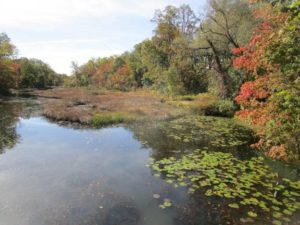
The fall foliage colors on Lawrence Brook in the Deans section of South Brunswick, Middlesex County.
FALL FOLIAGE: The peak of the colors is a little late this year, but this coming week should be very nice for viewing. The combination of fallen leaves and rain can make slippery driving conditions. So, be careful driving.
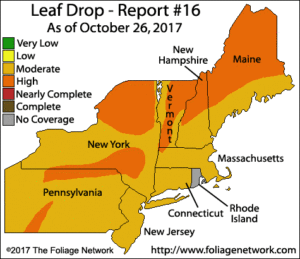
Northeastern United States fall foliage map. (Copyright 2017 by the Foliage Network.)
DEER RUT: Speaking of being careful when driving, look out for deer, “Odocoileus virginianus,” because the rut, or mating season, is on – meaning sex-crazed deer are running around. Normally, bucks stay out of sight, while it is common to see does and their brood. But over the last few weeks, I have noticed movement by bucks. During this week, I have seen a buck along the woods edge at Helmetta and in a driveway in a wooded area of East Brunswick, both in Middlesex County. If dividing the rut into three chapters of one, bucks challenging other bucks and chasing does, two, mating, and three, a wind-down, I would say we are in stage one on the cusp of stage two. The rut will extend to about mid-December.
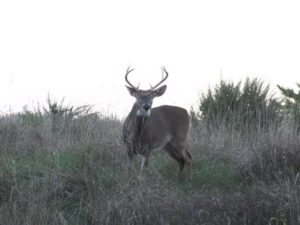
I shot this 7-point buck (with a camera) in 2015, October, just north of the Jersey Midlands near the Metropark railroad station area of Woodbridge, Middlesex County.
WINTER IS COMING: I have been gazing at the constellation Orion, easily identified in the night sky by its belt of three stars. When we can see Orion, it means we are in the colder weather part of the year. And cold weather means being on the lookout for snow. On 2008, October 28, it snowed in the Helmetta area of Middlesex County, but there was little, if any, accumulation. (The average snowfall in the New Brunswick, Middlesex County, area, for example, is 25.8 inches.)
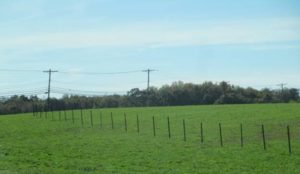
A sign of winter: fencing on farmland to prevent drifting snow. Here on a farm in Upper Freehold, Monmouth County, stakes for snowfencing are in place.
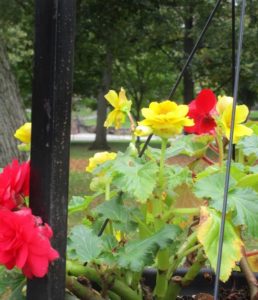
A little bit of lingering warm weather, a little taste of future cold weather — that is this time of year. Here, flowers in bloom on Voorhees Mall at Rutgers University—New Brunswick, Middlesex County.
“SNOWBIRDS”: Has anyone seen the first “snowbird,” or junco, “Junco hyemalis,” of the cold-weather season? I have not noticed any yet, but likely will see one soon, because I normally see the first one of the season around Halloween.
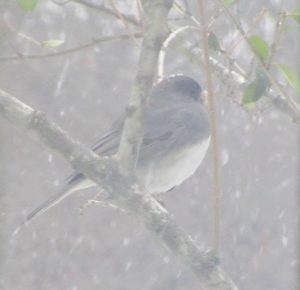
A “snowbird” in my yard in March of this year. They are a cold-weather bird in the Jersey Midlands. Normally, I begin seeing them around Halloween.
BIRD-FEEDING: For the first time in years, I did not feed birds this summer. Although I love zoning out and watching birds at my backyard feeder, I decided to put the birds visiting my yard to work, that is, eating insects – and from my end, saving money on birdseed. But this week, with food gardening pretty much over for the year and cold weather scaring off insects, I resumed feeding. It seemed to take a few days to attract birds to the feeder, but they are now there – blue jay, “Cyanocitta cristata”; chickadee, probably “Poecile carolinensis”; titmouse, “Baeolophus bicolor”; and nuthatch, “Sitta carolinensis.” And I await more species.
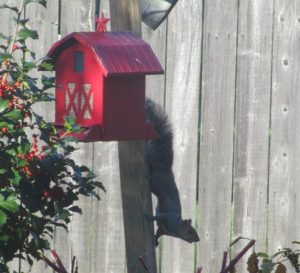
A gray squirrel, “Sciurus carolinensis,” testing the squirrel guard on my backyard birdfeeder. I will have to keep an eye on it to see who wins, feeder or squirrel.
DRY CONDITIONS: All of the Jersey Midlands’s seven counties are below average for rain over the last three months. Through October 27, Friday, Hunterdon received 8.5 inches, down 4.0 inches; Somerset, 9.6 inches, down 2.7 inches; Middlesex, 10.0 inches, down 2.1 inches; Mercer, 7.5 inches, down 4.5 inches; Monmouth, 8.2 inches, down 3.5 inches; Ocean, 9.0 inches, down 2.4 inches; and Burlington, 9.4 inches, down 2.4 inches.

Middlesex County’s Farrington Lake is low. Here, looking from the South Brunswick-East Brunswick boundary across the lake to North Brunswick.
THE WIND: On the morning of Tuesday, October 24, I went to the Helmetta Post Office, where I am third generation with Box 275, to pick up my mail. There, I noticed American flags at the Fire Department and at the historic Avon Inn snapping in the wind. Judging by the flags, the wind was blowing up to 8 to 12 miles per hour. Wind speed can be judged by its impact on flags, trees, and smoke, for example.
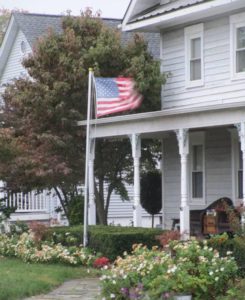
An American flag snaps to the wind at Helmetta’s historic Avon Inn, now a private residence. It dates back as a circa late 1800s-early 1900s inn positioned near a railroad station. (Think of the hotel on the 1963-1970 television sitcom “Petticoat Junction.”)
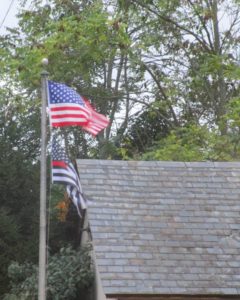
Another American flag in the wind at the Helmetta firehouse and old George W. Helme Snuff Mill pumphouse, which sits on the mill race leading from the former mill to Manalapan Brook.

This is an easy-to-use wind chart from universetoday.com. (Graphic copyright 2017 by universetoday.com.)
CLOUDS OVER NEW BRUNSWICK: During a break from my work in the Plangere Writing Center at Rutgers University’s Murray Hall in New Brunswick, Middlesex County, I looked out a window and noticed the clouds over the Johnson and Johnson pharmaceutical company headquarters along the Raritan River. Again, a beautiful display by Mother Nature:

Clouds over Johnson and Johnson pharmaceuticals headquarters along the Raritan River in New Brunswick, Middlesex County. Photograph from Murray Hall on the Rutgers University downtown campus.
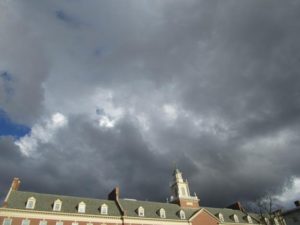
Another photo of clouds over the J&J building in New Brunswick, Middlesex County.
LOST MAN IN THE PINE BARRENS AROUND HELMETTA: A 68-year-old was rescued after becoming lost and weakened during a walk in an East Brunswick, Middlesex County, section of the Jamesburg Park Conservation Area. The man apparently was not physically injured. But he had suffered a stroke about 10 years ago and has physical, cognitive, and speech limitations, according to family friends and officials. Rescuers first had to locate the man. Then, those rescuers were lost and had to be guided out of the woods. A State Police helicopter was called in to light up the woods and find the victim and his rescuers. The helicopter, then, guided them out before it had to leave because it was low on fuel. The rescue took about four hours until about 9:30 p.m. Because of the swampy and woodsy terrain, the man had to be hand-carried out on a stretcher. The Jamesburg Conservation Area, which is owned by Middlesex County Parks and Recreation, is about 1,400 acres of woods, swamp, waterways, and bodies of water, including Helmetta Pond.
HELMETTA POND, GOOD FOR THE SOUL: Ralph “Rusty” Richards, a mentor of mine in the Pine Barrens around Helmetta, Middlesex County, and I were talking at Helmetta Pond when this unfamiliar woman walked by and told us she was going to wet her feet in the Pond. It sure looked good for the soul.
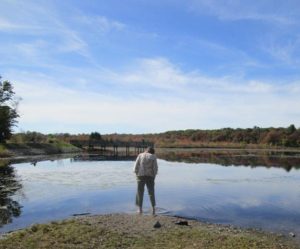
Wading woman at Helmetta Pond.
DRIVE-BY FARM SCENES: In my travels, I photographed various farm scenes in South Brunswick and Monroe, both in Middlesex County, and Upper Freehold, Monmouth County.
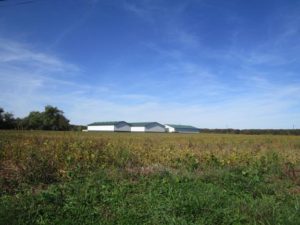
A farm in South Brunswick, Middlesex County.
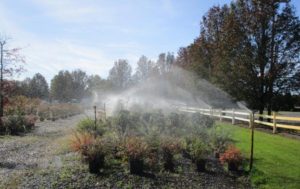
Lark Nurseries in Monroe, Middlesex County.
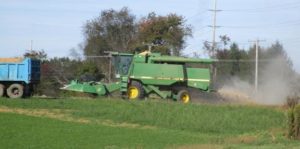
A combine works a field in Upper Freehold, Monmouth County.

Irrigation equipment on a sod farm in Upper Freehold, Monmouth County.
OCEAN TEMPERATURES: Atlantic Ocean temperatures on the New Jersey coast were about 61 degrees to 64 degrees on the October 28-29 weekend.
CHANGE THE CLOCKS: We switch from Daylight Savings Time to Standard Time November 5, Sunday, at 2 a.m., the clocks moving back to 1 a.m.
SUNRISE/SUNSET: For October 29, Sunday, to November 4, Saturday, the sun will rise about 7:25 to 7:30 a.m. and set about 5:55 p.m. For November 5, Sunday, to November 11, Saturday, the sun will rise about 6:35 a.m. set about 4:45 p.m.
WEATHER: The National Weather Service forecasting station for the area is at http://www.weather.gov/phi/.
THE NIGHT SKY: The next full moon is the Frost Moon on the Friday-Saturday, November 3-4, overnight.
“WAR OF THE WORLDS” BROADCAST: When you look into the night sky, something may be looking back… On 1938, October 30, Mischief Night, the Jersey Midlands were invaded by Martians in Orson Welles and the Mercury Theatre on the Air’s adaptation of H.G. Wells’s “The War of the Worlds.” The broadcast, https://www.youtube.com/watch?v=9q7tN7MhQ4I.
UPCOMING: October 29, Sunday, 1:30 p.m., from Clean Ocean Action: “There will be a commemoration of lives, homes and businesses lost as a result of (2012’s) Superstorm Sandy. There will be a rally followed by brief comments from various elected officials and the major candidates for Governor. Attendees will line the Asbury Park boardwalk from end to end demonstrating the urgent need to address climate change. The call to action will be captured by aerial photography as attendees hold hands across the boardwalk. For more information or to get involved, contact Ed Potosnak, NJ League of Conservation Voters at ed.potosnak@njlcv.org. RSVP today at njlcvef.org/sandy.”

A tree eats a traffic sign in South Brunswick, Middlesex County.
Joe Sapia, 60, is a lifelong resident of Monroe in South Middlesex County. He is a Pine Barrens naturalist and a gardener of organic vegetables and fruit, along with zinnias and roses. He draws inspiration on the Pine Barrens around Helmetta from his mother, Sophie Onda Sapia, who lived her whole life in these Pines, and his Polish-immigrant grandmother, Annie Poznanski Onda. He gardens the same backyard plot as did his Italian-American father, Joe Sr., and Grandma Annie. Both are inspirations for his food gardening. Ma inspires his rose gardening. Joe’s work also is at @JosephSapia on Twitter.com, along with Facebook.com on the Jersey Midlands page.
Except as noted, article and photos by Joe Sapia
Note: The yard references are to my house in the section of Monroe between Helmetta and Jamesburg in South Middlesex County. My yard is in a Pine Barrens outlier on the Inner Coastal Plain, the soil is loamy, and my neighborhood is on the boundary of Gardening Zones 6b (cooler) and 7a (warmer). Notes and photographs are for the period covered, unless otherwise noted.
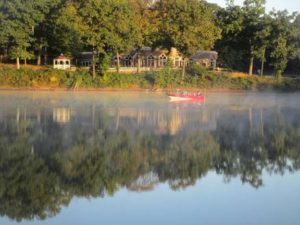
Morning on Farrington Lake, looking from East Brunswick to North Brunswick, both in Middlesex County, at the Hardenburg Lane bridge. Being on New Jersey’s Coastal Plain, where there are few, if any, natural bodies of water, Farrington Lake is created by the damming of Lawrence Brook between Davidson Mill Pond Park and Milltown.
FIRETOWERS: New Jersey’s fall wildfire season coincides with leaves falling and normally runs until about Thanksgiving and that time of year’s colder temperatures. But there could be a wildfire threat at any time if conditions are correct — and, now, we have had both falling leaves and dry conditions. So, the state Forest Fire Service is staffing its lookout towers. Visitors are welcome to go up in the towers when they are staffed – but, remember, you not only have to walk up the tower stairs, but you have to walk down. These Forest Fire Service towers are in the Jersey Midlands: Jamesburg/Middlesex County, Lakewood/Ocean County, Cedar Bridge/Ocean County, Medford/Burlington County, Lebanon/Burlington County, Apple Pie Hill/Burlington County, Batsto/Burlington County, and Bass River/Burlington County.
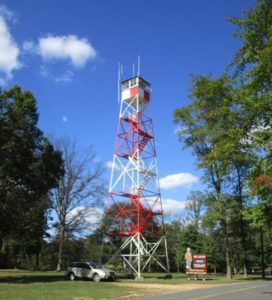
“Jamesburg Tower,” actually outside of Jamesburg in a Monroe Township section of Thompson Park, is about 65-feet-tall, sitting on high ground of about 150 feet above sea level over the Raritan River watershed.
GREAT HORNED OWL: Late at night, as I was at my desk, I thought I heard one of my favorite night sounds, the resonating hoot, hoot, hoot of a great horned owl, “Bubo virginianus.” I went outside and heard what I thought was a faint call of one, then nothing. The great horned is an early breeder, so the calling, signally both territory and looking for mates, should increase. More information, including audio of its calls, is at Cornell University’s All About Birds website, https://www.allaboutbirds.org/guide/Great_Horned_Owl/id.
BALD EAGLE, OCEAN COUNTY: Diane Larson, the home horticulturist and leader of the Master Gardeners program in Rutgers University’s Cooperative Extension Office/Monmouth County, sent in this photograph taken by her stepson, Danny Larson. It is a juvenile bald eagle, photographed on the afternoon of Thursday, October 5, on Beaver Dam Creek in Brick, Ocean County. Diane was leaning toward bald eagle, “Haliaeetus leucocephalus,” but raised a question if it could be a golden eagle, “Aquila chrysaetos.” Two New Jersey Audubon Society naturalists, Pete Bacinski (retired) and Scott Barnes (active) made the identification via this photograph. “It is a juvenile bald eagle,” Pete said. “The bill is too large for (a) golden.” “Yes, definitely a juvenile bald eagle,” Scott said. (Thank you, Danny, Diane, Pete, and Scott, for the team effort.)
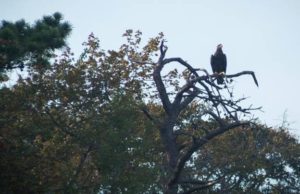
Danny Larson photographed this juvenile bald eagle on Beaver Dam Creek near his family’s house in Brick, Ocean County. (Photography copyright 2017 by Danny Larson.)
DRIVE-BY NATURALIST, DOUBLE-CRESTED CORMORANT: As I drive through the Pigeon Swamp area of South Brunswick, Middlesex County, I pass a warehouse area. There, I often see a double-crested cormorant, “Phalacrocorax auritus,” at a retention pond.

A double-crested cormorant in a retention pond in South Brunswick, Middlesex County.
STEAMING FARRINGTON LAKE: When water temperature is much warmer than air temperature, bodies of water look like steaming soup. I caught this view of Farrington Lake on a cool morning. A few winters back, when we experienced real cold temperatures, this phenomenon was seen at the Atlantic Ocean – a really cool view.
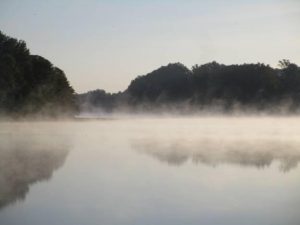
A steamy Farrington Lake, looking from East Brunswick to North Brunswick.
FALL ON THE FARMS: It is fall, so farms are displaying pumpkins and chrysanthemums. Field corn, or feed corn, awaits harvesting.
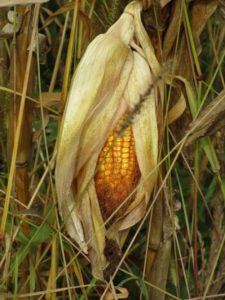
Field corn awaits harvesting in South Brunswick, Middlesex County
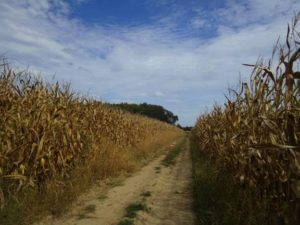
Acres of field corn await harvesting in South Brunswick

Chrysanthemums at Davino’s Nursery in East Windsor, Mercer County.
CLOUDS, NO. 1: One of the week’s beautiful clouds and sky view was from the East Windsor Community Garden in Mercer County.
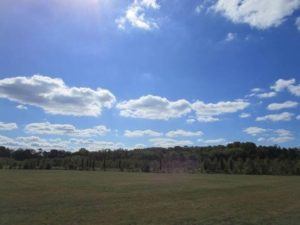
Beautiful clouds and sky view at East Windsor Community Garden in Mercer County.
CLOUDS, NO. 2: Another view of beautiful sky with clouds was from my backyard in Monroe, Middlesex County.

A clouds-in-the-sky view from my backyard in Monroe, Middlesex County.

Another clouds-in-the-sky view from my backyard.
OCEAN TEMPERATURES: Atlantic Ocean temperatures on the New Jersey coast were about 69 degrees to 71 degrees during the weekend of October 7 and 8.
SUNRISE/SUNSET: For October 8, Sunday, to October 14, Saturday, the sun will rise about 7:05 a.m. and set about 6:25 p.m. For October 15, Sunday, to October 21, Saturday, the sun will rise from about 7:10 to 7:15 a.m. and set about 6:10 to 6:15 p.m.
THE NIGHT SKY: The next full moon is the Frost Moon on the November 3-4 overnight.
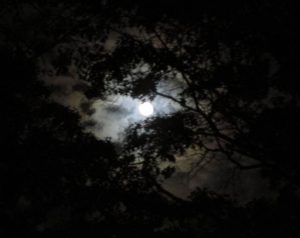
The moon over Manalapan Brook and its floodplain in Monroe, Middlesex County. This moon is waning after October 5’s Full Harvest Moon.
WEATHER: The National Weather Service forecasting station for the area is at http://www.weather.gov/phi/.

A view from Jamesburg Tower, looking south toward Monroe Township High School, from the spring of 2014.
Joe Sapia, 60, is a lifelong Monroe resident. He is a Pine Barrens naturalist and an organic vegetable-fruit gardener. He gardens the same backyard plot as did his Italian-American father, Joe Sr., and his Polish-immigrant, maternal grandmother, Annie Poznanski Onda. Both are inspirations for his food gardening. Joe is active with the Rutgers University Master Gardeners/Middlesex County program. He draws inspiration on the Pine Barrens around Helmetta from his mother, Sophie Onda Sapia, who lived her whole life in these Pines, and his Grandma Annie. Joe’s work also is at @JosephSapia on Twitter.com, along with Facebook.com on the Jersey Midlands page. Copyright 2017 by Joseph Sapia
Article and photos by Daniel Cohen, Rutgers University junior
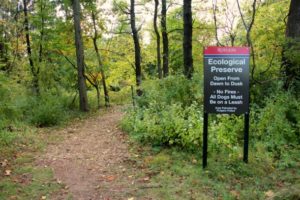
As a lifelong resident of Highland Park, and currently a student at Rutgers I have greatly enjoyed hiking throughout the university’s Ecological Preserve, a relatively pristine area located on the Livingston Campus. The Rutgers Preserve was established in 1976 as an ecological resource. Its purpose is to serve as an aesthetic, educational, and recreational area for the Rutgers community as well as for the residents of New Jersey. This 360-acre Eco-Preserve is the habitat of numerous creatures including migrant songbirds (warblers and towhees). It is also the home of the white-tailed deer. The Preserve is the site of native plants such as Spring Ephemerals and Jack-in-the-Pulpit, as well as Ash, Beech, Hickory, and Red Oak trees.
Anyone concerned with environmental matters in the Lower Raritan Watershed should be aware of the proposed Rutgers “Innovation Park” (IP) plan – an infrastructure project to be constructed adjacent to the Rutgers Eco-Preserve site. Rutgers has requested that the New Jersey Commission of Budgeting and Planning allocate $4.75 billion for infrastructure projects on its campuses as part of a Master Plan. Included in this proposal is funding for IP, a major project to be built on the edge of the Preserve. According to the Rutgers publication Business Plan and Implementation Strategy (2016), its purpose is to “promote research collaborations, technology transfer and commercialization, job creation, and public-private partnerships.” IP, an inter-disciplinary learning site with a goal of furthering environmentalism is well-intentioned.
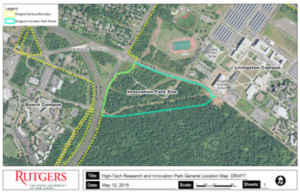
However, a project whose mission is environmental may nevertheless be harmful to the Preserve’s ecosystem. A major building project occurring just outside the Eco Preserve’s borders may well threaten fauna and flora within the Preserve itself. The project will result in pollutants from trucks and construction machinery as well as in greater noise levels. Fossil fuel emissions, the primary cause of climate change, have already caused the destruction of species of animals and plants worldwide. Excessive construction noise is harmful to the well-being of animals and plants as fossil fuel emissions and increased decibel levels will not stop at the Preserve’s periphery. The essential question is to what degree, the site will be impacted.
If it has not yet done so, Rutgers must conduct a thorough environmental review of the effects of this infrastructure project. Although in the Rutgers publication there is an environmental assessment of the IP site itself, there is no reference to its impact on the adjacent Eco-Preserve. There should be a comprehensive environmental assessment regarding how the IP project will impact this area. Residents of Central New Jersey and beyond, including members of the Rutgers community who care about protecting this vital habitat, must be given the opportunity to interact with those involved with this project.
Article and photos by Joe Mish
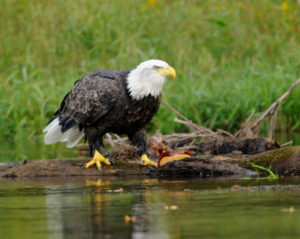
The food chain is not a one way street, as a turtle whose kin may feed on baby ducks, gets picked on by a bald eagle
It is unthinkable to imagine a restaurant where the diners are often listed as menu items. Though when seated at nature’s dinner table, the catch of the day takes on a whole new meaning as predators and prey freely alternate position. The dietary choices are also a surprise as the variety of delectable meals is often at odds with expectations.
Sorting through my library of photos, I was perplexed trying to categorize some images showing two species in close contact. Obviously notable was the reversal of who was eating who.
The first image which prompted these thoughts was captured as I launched my canoe. Here was a very young painted water snake, brilliant colored markings, with a fish sticking out its mouth. Comparing the size of the snake to the fish, I wondered if the snake ‘bit off more than he could chew’, as they say. The fish was wider than the snake and it didn’t look like much progress was being made in the attempt to swallow it. I couldn’t identify the species of fish but thought it a moment of karma as small mouth bass which inhabit the river are well known to forage on anything that swims or crawls in the waters of the south branch. A small snake would hardly be ignored by a hungry bass.
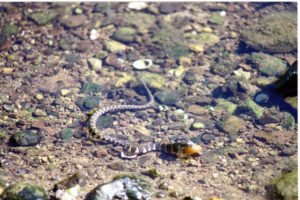
Another image shows a larger painted water snake suspended on o vertical river bank holding onto the tail of a gold colored catfish. As the snake was in an awkward position and didn’t want to go into the water, it was a standoff with the advantage going to the snake. The fish would struggle and then lay still. Eventually the fish broke free. I then remembered a series of images documenting another struggle where a snapping turtle grabbed a painted water snake by the tail. As I paddled along, I saw a water snake swimming across the river and as it neared the opposite bank it suddenly reared up and began to thrash about. Mystery solved as a snapping turtle soon surfaced holding on tight, as the snake now alternated struggling and lying still. As I drifted closer, the turtle was intimidated into releasing its grip and the snake swam off.
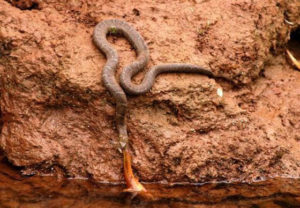
A painted water snake has a catfish by the tail. The snake is barely holding on to the vertical bank , using a tuft of grass to secure its precarious position. the catfish would struggle mighily and then rest. After several tries the catfish appeared dead and lay still for quite some time. Suddenly the catfish came to life and broke free. Again, the scene was captured from a canoe.
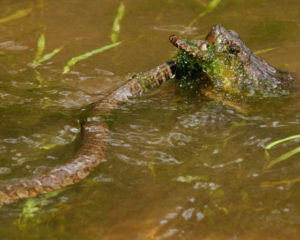
A painted water snakes has the tables turned on it as a snapping turtle reached up to grab the snake swimming across the river.
Turtles are not immune from the proverbial soup bowl as they are prey to many birds and animals that share the same habitat. Even large water snakes will easily swallow a turtle hatchling seeking cover in the water, as will great blue herons, mink, fox, skunk, raccoon and birds of prey.
In a twist of fate, the turtle that killed baby ducks in a farm pond yesterday could very well be on a larger bird’s menu today.
Such was the case when I spotted a bald eagle standing on a log near shore, intently pulling and tearing away at what was probably a deer carcass or white sucker. The eagle would occasionally look up and certainly it saw me from two hundred yards away, apparently not at all intimidated. As I closed the distance, a bright yellow object was clearly visible and the focus of the eagle’s rapt attention. I began to take photos, drifting ever closer and as I started to pass the eagle, it flew off. It was then I realized the eagle was dining on a painted turtle!
Across the land where rivers flow, the lines between predator and prey begin to blur. Don’t be surprised when a squirrel is seen carry a baby crow or a muskrat is swimming underwater holding a baby blue jay or a blue jay is flying off with a dead vole. If you can’t imagine it, it is happening somewhere along our wild rivers.

Muskrat with a bluejay swims into its den’s underwater entrance. Mystery for sure.
Author Joe Mish has been running wild in New Jersey since childhood when he found ways to escape his mother’s watchful eyes. He continues to trek the swamps, rivers and thickets seeking to share, with the residents and visitors, all of the state’s natural beauty hidden within full view. To read more of his writing and view more of his gorgeous photographs visit Winter Bear Rising, his wordpress blog. Joe’s series “Nature on the Raritan, Hidden in Plain View” runs monthly as part of the LRWP “Voices of the Watershed” series. Writing and photos used with permission from the author.
Article and photos by Joe Sapia (except as noted)
Note: The yard references are to my house in the section of Monroe between Helmetta and Jamesburg in South Middlesex County. My yard is in a Pine Barrens outlier on the Inner Coastal Plain, the soil is loamy, and my neighborhood is on the boundary of Gardening Zones 6b (cooler) and 7a (warmer). Notes and photographs are for the period covered, unless otherwise noted.
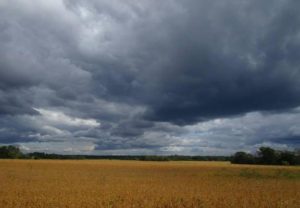
Gray clouds over Monroe farmland, looking toward the Jamesburg Park Conservation Area. Beautiful cloudy skies have presented themselves in recent years over my hometown of Monroe.
FALL HAS ARRIVED: Despite the summer-like temperatures the Jersey Midlands have been experiencing, fall is here. The calendar proclaims the beginning of fall at the September equinox – this year, September 22, when the day’s light and dark are generally equal. However, I regard fall beginning September 1 and running through October and November.
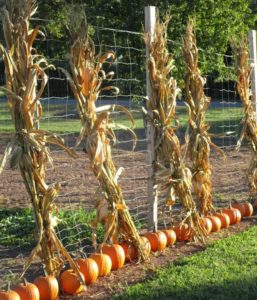
A fall scene at Griggstown Farm in Franklin, Somerset County.
DEER RUT: The mating season, or rut, for deer, “Odocoileus virginianus,” normally peaks from late October to mid-December. Here is Nixle.com-South Brunswick, Middlesex County, advisory:
“The South Brunswick Police Department is reminding motorists to be alert for increased deer activity over the next six weeks. This is typically when we see an increase in car crashes involving deer. The deer can unexpectedly dart onto roads so motorists need to use extra caution. “Motorists are urged to be especially attentive and cautious during morning and evening commutes when visibility may be poor. Deer are involved in thousands of collisions annually in New Jersey, with as many as half coming during the fall mating season, or rutting season…. An adult male deer can weigh 150 pounds or more.
“In the past month there have been a half dozen crashes involving deer in South Brunswick. In past years the majority of crashes have taken place over the next 6 weeks.
“…Deer are most active in the very early morning and around sunset, when visibility conditions can be very difficult. Using caution while driving will become even more important when Daylight Saving Time ends November 6, causing commutes to align with periods when deer are most active. For motorists, low levels of light and sun glare can make it very difficult to see deer that are about to cross the road. Moreover, multiple deer may cross the road at any given moment, usually in a single file.
The following tips can help motorists stay safe during from deer crashes:
-If you see a deer, slow down and pay attention to possible sudden movement. If the deer doesn’t move, don’t go around it. Wait for the deer to pass and the road is clear.
-Pay attention to ‘Deer Crossing’ signs. Slow down when traveling through areas known to have a high concentration of deer so you will have ample time to stop if necessary. If you are traveling after dark, use high beams when there is no oncoming traffic. High beams will be reflected by the eyes of deer on or near roads. If you see one deer, be on guard: others may be in the area. Deer typically move in family groups at this time of year and cross roads single-file. Don’t tailgate. Remember: the driver in front of you might have to stop suddenly to avoid hitting a deer.
-Always wear a seatbelt, as required by law. Drive at a safe and sensible speed, considering weather, available lighting, traffic, curves and other road conditions.
-If a collision appears inevitable, do not swerve to avoid impact. The deer may counter-maneuver suddenly. Brake appropriately, but stay in your lane. Collisions are more likely to become fatal when a driver swerves to avoid a deer and instead collides with oncoming traffic or a fixed structure along the road.
-Report any deer-vehicle collision to a local law enforcement agency immediately.
-Obey the state’s hands-free device law or, better yet, avoid any distractions by refraining from using cellular devices while driving.

I encountered these deer near Rutgers University–Douglass College in New Brunswick, Middlesex County. These are city deer, allowing me to get within 30 or so feet of them.
WEARING BLAZE ORANGE: With the popular deer-hunting season underway, it is probably a good time to wear blaze orange in the woods. Actually, a few years ago, I started wearing blaze orange on my knapsack year-round, because it is hard to keep track of hunting. During the last deer-hunting season, I walked under a tree-stand with a hunter, never seeing him until he spoke to me. Fortunately, I wore blaze orange. (The incident showed me, no matter a life spent in the woods, I let down my awareness.)

My blaze orange vest and one of my blaze orange hats.
BALDFACED HORNET NESTS: As we transition from the warm weather season to the cold, baldface hornets, “Dolichovespula maculate,” will abandon their nests. The abandoned nest is not a threat and may make a folksy bringing-of-the-outdoors-inside ornament. I have two hanging, with another waiting to be hung, in my cellar “cabin” area. Scope your nest now, but wait for colder weather to make sure it is fully abandoned. (Even in season, these nests are not a threat, if far-enough away from human activity. See this Pennsylvania State University Extension factsheet, http://ento.psu.edu/extension/factsheets/baldfaced-hornet.)
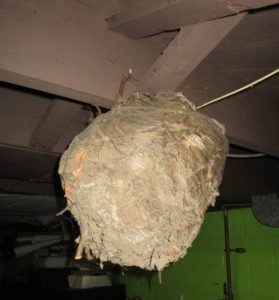
A baldfaced wasp nest on display in my cellar.
MONARCH BUTTERFLIES: Last week, I mentioned monarch butterflies, “Danaus plexippus,” would be heading on their southern migration to either Florida or, more likely, Mexico. The monarchs we see now are a “super generation,” the great-grandchildren of last fall’s migration and these making the complete trip south, if they survive. This week, I was able to photograph one in my garden as it visited the zinnias.
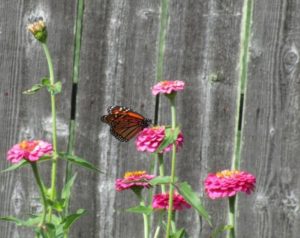
A monarch butterfly on the zinnias in my garden. If all goes right, this butterfly will migrate to at least Florida or, more likely, Mexico. Good luck!
ZINNIAS AND LETTUCE: This week, my zinnias went to Teddy’s luncheonette in Cranbury, Middlesex County, and the Hightstown Diner in Hightstown, Mercer County. The fall lettuce crop in my garden is growing nicely.

The fall lettuce crop in my garden.
GARDEN VOICES: Paul Migut, who gardens in South River, Middlesex County, checked in: “(I) pulled out all Rutgers and yellow tomatoes. (I) still have two grape/cherry tomatoes and two bush beans. And, of course, the ‘surprise’ turnips still growing. Enjoy the Fall season.”

Cherry tomatoes and bush beans from Paul Migut’s garden in South River, Middlesex County. (Photograph copyright 2017 by Paul Migut.)
BEAUTIFUL CLOUDS: The beautiful cloud formations continue. This week, among the places I photographed them was “Jamesburg Lake” (properly “Lake Manalapan”) on the Jamesburg-Monroe boundary, Middlesex County.

Clouds over “Jamesburg Lake,” Middlesex County.
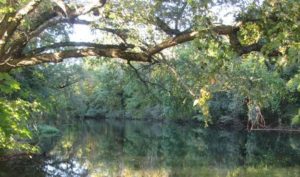
The Delaware and Raritan Canal on the boundary of Rocky Hill and Franklin, Somerset County.
OCEAN TEMPERATURES: Atlantic Ocean temperatures on the New Jersey coast were about 68 degrees to 70 degrees during the weekend of September 30-October 1.
SUNRISE/SUNSET: For October 1, Sunday, to October 7, Saturday, the sun will rise about 6:55 to 7 a.m. and set about 6:30 to 6:40 p.m. For October 8, Sunday, to October 14, Saturday, the sun will rise about 7:05 a.m. and set about 6:25 p.m.
THE NIGHT SKY: The next full moon is the Full Harvest Moon Thursday, October 5.
WEATHER: The National Weather Service forecasting station for the area is at http://www.weather.gov/phi/.
UPCOMING: Another “Rally for the Navesink” meeting is scheduled for Tuesday, October 3, 5:30 p.m., at the Monmouth Boat Club, 31 Union Street, Red Bank. The Rallies are an effort of environmental groups, the community, and municipal, Monmouth County, and state governments to promote improvement of the Navesink River in Monmouth County. The river suffers from high fecal bacteria counts and depleted oxygen levels. More information on the Rally is available from Clean Ocean Action, telephone 732-872-0111, website www.cleanoceanaction.org.
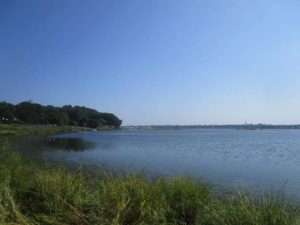
The Navesink River in September, looking downstream from Middletown toward Sea Bright, Monmouth County.

The recent photograph shows Sandy Hook, where the Atlantic Ocean and Raritan Bay meet, from an airplane flight leaving LaGuardia Airport in New York City. Humans, how small we are! (Photograph copyright 2017 by Dan Mulligan, a Long Branch, Monmouth County, kid who, now, lives in Cranbury, where he is on the Township Committee and has served as mayor.)
Joe Sapia, 60, is a lifelong Monroe resident. He is a Pine Barrens naturalist and an organic vegetable-fruit gardener. He gardens the same backyard plot as did his Italian-American father, Joe Sr., and his Polish-immigrant, maternal grandmother, Annie Poznanski Onda. Both are inspirations for his food gardening. Joe is active with the Rutgers University Master Gardeners/Middlesex County program. He draws inspiration on the Pine Barrens around Helmetta from his mother, Sophie Onda Sapia, who lived her whole life in these Pines, and his Grandma Annie. Joe’s work also is at @JosephSapia on Twitter.com, along with Facebook.com on the Jersey Midlands page.
 The foliage change of colors may be past its peak, but the colors continue to dazzle. Here, morning sunlight shines on a cove in a section of Farrington Lake on the East Brunswick-North Brunswick boundary in Middlesex County.
The foliage change of colors may be past its peak, but the colors continue to dazzle. Here, morning sunlight shines on a cove in a section of Farrington Lake on the East Brunswick-North Brunswick boundary in Middlesex County.





































































































